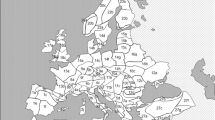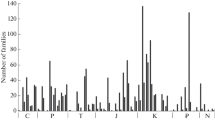Abstract
Investigations of subfossil Coleoptera show that during the last few hundreds of thousands of years, species have remained evolutionarily constant. They have, however, altered their geographical distributions extensively in response to the climatic changes of the glacial/interglacial cycles. It can be demonstrated that many species which have today a Mediterranean range, extended their northern limits during the warmer interglacial and interstadial interludes, at least as far as the British Isles. These species comprised groups of varied ecological preferences and some have such restricted present day distributions that they have been viewed as ‘endemic’ Mediterranean species. Patterns of present day geographical distributions are thus the result of dynamic interaction between the species and the numerous and intense climatic changes that caused continuous biogeographic adjustments. This complex history can only be understood adequately by reference to the subfossils which provide the only objective evidence of where species lived in the geologically recent (and ecologically relevant) time.
Access this chapter
Tax calculation will be finalised at checkout
Purchases are for personal use only
Preview
Unable to display preview. Download preview PDF.
Similar content being viewed by others
References
Atkinson, T.C., Briffa, K.R. & Coope, G.R. 1987. Seasonal temperatures in Britain during the past 22,000 years, reconstructed using beetle remains. Nature 325: 587–592.
Coope, G.R. 1973. Tibetan Species of Dung Beetle from Late Pleistocene Deposits in England. Nature (London) 245: 335–335.
Coope, G.R. 1978. Constancy of insect species versus inconstancy of Quaternary environments. In L.A. Mound & N. Waloff (eds.), Directory of Insect Faunas, Blackwell, Oxford, pp. 176–187.
Coope, G.R. 1979. Late Cenozoic Coleoptera: Evolution, Biogeography and Ecology. Annual Reviews of Ecology and Systematics 10: 247–267.
Coope, G.R. & Angus, R.B. 1975. An ecological study of a temperate interlude in the middle of the last glaciation, based on fossil Coleoptera from Isleworth, Middlesex. Journal of Animal Ecology 44: 365–391.
Girling, M.A. 1974. Evidence from Lincolnshire of the age and intensity of the mid-Devensian temperate episode. Nature (London) 250: 270.
Joachim, M.J. 1978. Late-glacial coleopteran assemblages from the west coast of the Isle of Man. Unpublished PhD Thesis, Department of Geological Sciences. University of Birmingham.
Lindroth, C.H. 1943. Oodes gracilis Villa. Eine thermophile Carabide Schwedens. Notulae Entomologicae 22: 109–157.
Pennington, W. 1986. Lags in adjustment to climate caused by the pace of soil development: Evidence from Britain. Vegetatio 67: 105–118.
Shotton, F.W. & Osborne, P.J. 1965. The fauna of the Hoxnian Interglacial deposits of Nechells, Birmingham. Philosophical Transactions of the Royal Society of London. B, 248: 353–378.
Van Geel, B., De Lang, L. & Wiegers, J. 1984. Reconstruction and interpretation of the local vegetational succession of a Late Glacial deposit form Usselo (The Netherlands), based on the analysis of micro- and macrofossils. Acta Botanica Neerlandica 33-34: 535–546.
Editor information
Rights and permissions
Copyright information
© 1990 Kluwer Academic Publishers, Dordrecht
About this chapter
Cite this chapter
Coope, G.R. (1990). The invasion of Northern Europe during the Pleistocene by Mediterranean species of Coleoptera. In: di Castri, F., Hansen, A.J., Debussche, M. (eds) Biological Invasions in Europe and the Mediterranean Basin. Monographiae Biologicae, vol 65. Springer, Dordrecht. https://doi.org/10.1007/978-94-009-1876-4_12
Download citation
DOI: https://doi.org/10.1007/978-94-009-1876-4_12
Publisher Name: Springer, Dordrecht
Print ISBN: 978-94-010-7337-0
Online ISBN: 978-94-009-1876-4
eBook Packages: Springer Book Archive




